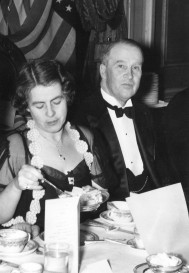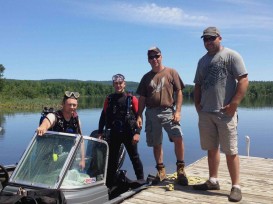Day 27 – New life and death on the Trans-Canada – and getting stuck
Sudbury, Ontario
Percy Gomery and ‘the Skipper’
Share
Sudbury, Ontario
Trans-Canada distance: 3,108 km
Actual distance driven: 7,840 km
THEN: (Deux Rivieres) Percy Gomery and his wife “the Skipper,” who I introduced in yesterday’s blog, left in late June, 1920, after a sleepless night in Rapides des Joachims, to drive north to Mattawa.

The journey started well but quickly deteriorated as the road became more primitive. I’ll let Gomery explain from his book about the drive, A Motor Scamper ‘Cross Canada:
As the world is said to grow more giddy and dangerous with the declining sun, that execrable road did the same. For miles together it was just a succession of hidden mines into which the car plunged every few yards. Rank growth of years of grass hid both the pits and the huge rocks that threatened to tear the in’ards out of the engine if it was moving more than about two miles an hour. As it was, the car was buffeted about brutally and so frequently was something being bent or smashed that it ceased to be a matter of comment. Then would come an awful hill, a sort of precipice cut into broad steps on which were strewn boulders about the size of perambulators. Now and then we would gain a height from which we could look a mile or two ahead over a peopleless wilderness of foliage, with just the suggestion of a different shade of green showing where once a road clearing had been made.
“Is that where we’ve got to go?” the Skipper would groan…
After dodging fallen trees, raising others and repairing bridges, I miscalculated the height of a suspended trunk and the car top was torn off. The only thing in our favour was the weather and, about five o’clock, it commenced to rain. We cast longing eyes at a rather homey boarding house at Deux Rivieres station (the first hamlet in twenty-five miles), but decided to push on for Mattawa.

Immediately away from the houses, we passed into the woods again, there being no habitations or buildings whatever for fifteen miles. However, several miles along, the wheels dug their way into hopeless mire and insisted on calling it a day. I think a shovel would have saved us that night, but it was missing from our kit.
Sadly, we fished out the very necessaries, including the typewriter, and left our desolated little home with its broken running board, broken spring, broken lamps, flattened gas-tank, bent windshield and smashed top to the mercy of the rain and started back for Deux Rivieres. Our arms were full of parcels; it was wet and hot; the mosquitoes were eating us alive and we were desperately tired. Several times the Skipper became hysterical. I comforted her as well as I could; in fact I recall telling her how these hardships could only make us better pals…
Believe it or not, the drive grew even worse the next day when they tackled the road again and Gomery ended up abandoning his long-suffering wife to the bears while he sought help again from a swamp. Somehow, though, they made it through and drove all the way to Vancouver. They even stayed married. Want to read his excellent 1922 book? You can download it here in its entirety for free.

NOW: (Mattawa) Several times today, I’ve seen billboards beside the road that ask drivers to “Remember Adam.” They commemorate 5-year-old Adam Ranger, who was killed on the Trans-Canada Highway in 2000 outside his home east of Mattawa.
Adam was leaving his school bus and was struck by a pickup truck that didn’t stop, despite it being a clear day and all the emergency lights on the bus clearly flashing and visible for more than 1,500 metres. The pickup driver was convicted two years later of manslaughter, as well as criminal negligence causing death.
According to letsrememberadam.org, there are now more than 30 billboards sponsored by local businesses in northern and eastern Ontario, reminding drivers to stop for school buses.
*

The roundabout in Mattawa that links the Trans-Canada with Hwy. 533 is the first I’ve seen on the TCH, and it’s the first to be installed anywhere in Northern Ontario. It was opened at the end of last November to replace a T-junction and has apparently smoothed the flow of traffic considerably. Also, apparently, truckers hate it – it’s a very tight turn for a long tractor-trailer.
The roundabout cost nearly $13 million and left the small downtown area dug up for months. It’s part of an 11-kilometre stretch that’s being repaved and fixed up, but there are mixed feelings about all the roadwork: residents want a smooth road, but there are also plans for a bypass that has merchants worried for their futures.
“We’re not that worried, though,” said one woman who didn’t want to be named here. “It’s not going to happen in our lifetimes. There just isn’t the money for it.”

SOMETHING DIFFERENT … (Deux Rivieres) It’s estimated that up to 16 billion logs were floated down the Ottawa River from 1830 until 1989. Yes – billion, with a “b”. Of those logs, probably five per cent sank en route, which means, in the words of Shane Hogue, “we’re never going to run out of wood.”
Hogue’s Deep River Lumber company is one of several in Ontario that specializes in hauling sunken lumber out of the water. I met him as he tried to fix a leak on his pontoon boat, and his scuba divers and a truck driver waited to get back to work.
Most of the logs at this point in the river were cut after 1945, and lost when the river was flooded then to create the Rapides des Joachims dam just downstream. Shane and his crew locate them with sonar, then the divers go down, search them out with flashlights in the 10-metre deep water, and hook them to a winch on the pontoon boat.

The age of the logs can be told by the hammer stamps by the lumberjacks, says Shane. Sometimes they find really old wood from the 1800s with axe marks in distinctive notch patterns, such as Vs and turtle shapes. If you’re interested, take a look at Hogue’s company website to read all kinds of fascinating stories about the old lumberjacks.
Lumber salvage needs a government permit to make sure that the removal of the logs won’t affect the river. Ontario charges a stumpage fee of $27 per cubic metre, but Quebec is just happy to have the logs taken from the river bed and charges nothing, so Shane’s crew works on the Quebec side of the river. It’s expensive to remove the logs, though, and not everybody will pay the premium that must be charged for high-quality salvaged wood to cover its costs.
And in the wintertime, when the river is frozen – what happens then? “I have new twins,” says Shane. “In the wintertime, I’m Daddy Day Care.”